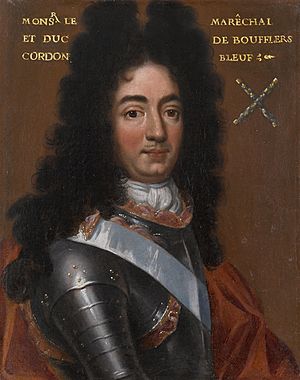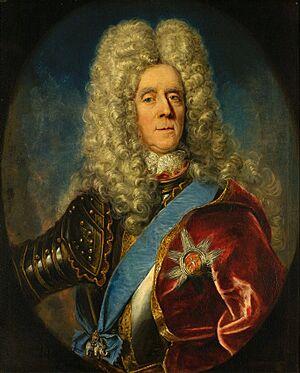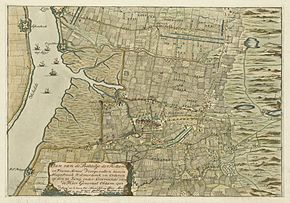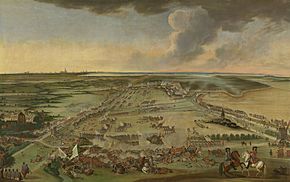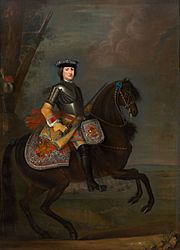Battle of Ekeren facts for kids
Quick facts for kids Battle of Ekeren |
|||||||
|---|---|---|---|---|---|---|---|
| Part of the War of the Spanish Succession | |||||||
|
|||||||
| Belligerents | |||||||
| Commanders and leaders | |||||||
| Strength | |||||||
| 12,000-15,000 | 19,000-25,000 | ||||||
| Casualties and losses | |||||||
| 1,700 killed or wounded 700 missing 2,500 killed or wounded, 800 captured |
At least 2,234 killed or wounded 2,300 killed or wounded |
||||||
The Battle of Ekeren happened on June 30, 1703. It was a fight during the War of the Spanish Succession. In this battle, the French army surrounded a smaller Dutch force. However, the Dutch managed to break through the French lines and get to safety. This battle didn't change much in the overall war.
Contents
Why Did the Battle of Ekeren Happen?
The War of the Spanish Succession started in the Netherlands in 1702. Early battles included the capture of Kaiserswerth and a failed French attack on Nijmegen. Marlborough, a British commander, led a large army of 60,000 soldiers. He decided to attack and move into the Spanish Netherlands.
How Rivers Helped Armies Move
Back then, land roads were not very good. So, rivers and canals were super important for moving armies and their supplies. Controlling a river meant you could transport everything your army needed much more easily. Marlborough followed the Meuse river, just like Frederick Henry had done years before. Fortresses along the Meuse, like Venlo, Stevensweert, Roermond, and Liège, were captured by the Allies during this time.
French Defenses and Allied Plans
The French commanders mostly watched these sieges. Their main goal was to protect the Brabant region. They built a long line of defenses that stretched from Antwerp to the Meuse river.
In 1703, the fighting began with the siege of Bonn. After Bonn surrendered, Marlborough's army joined forces with another army led by Ouwerkerk. Their goal was to stop the French army, led by Villeroy, from helping Bonn. For a while, both sides moved around without any big battles. Then, Marlborough decided to attack the French defenses.
Marlborough wanted to attack cities like Ostend and Huy to make the French move their troops away from Antwerp. But the Dutch leaders didn't agree with his plan. Instead, Marlborough planned to break through the French lines near Diest with his main army of 55,000 men. At the same time, two smaller Dutch groups would attack other parts of the French lines. One group, led by generals Coehoorn and Sparre, would attack near Dutch Flanders. Another group, led by Count Wassenaer Obdam, was to move towards Ekeren, a village near Antwerp.
Obdam's Dangerous Position
This plan was risky because Obdam's group and Coehoorn's group were separated by the Scheldt river. This meant they couldn't easily help each other if something went wrong. Obdam had to send some of his soldiers to Coehoorn, which made his own force smaller. On June 28, Obdam's army marched from Bergen op Zoom towards Antwerp. The next day, they reached Ekeren, which was only seven kilometers north of Antwerp.
Obdam's commanders, including the Lord of Slangenburg and Count of Tilly, saw the danger. They told Obdam that their position at Ekeren was risky. Obdam felt he had to follow his orders and stay in Ekeren, but he did tell Marlborough about the danger. Marlborough, however, ordered him to stay put.
If the Allies had attacked quickly everywhere, Obdam's danger might have been less. But this didn't happen. On June 27, Coehoorn and Sparre did attack and capture some French lines. However, Marlborough's main army started its attack too early. By the end of June, they had already used up supplies around Maastricht and Liège and needed to move. On June 29, they warned Obdam that Villeroy had sent Duc de Boufflers with part of the French army towards Antwerp. Obdam's army moved their supplies to safety, but they stayed in their positions.
The Battle of Ekeren Begins
On the morning of June 30, French dragoons (soldiers on horseback) marched from Merksem and Ekeren. They aimed to cut off the Dutch escape route near Hoevenen, which led back to Breda and Bergen-op-Zoom. The Marquis of Bedmar and his Spanish troops were near Wilmarsdonk. This meant the Dutch forces were surrounded. Most historians say the Dutch were greatly outnumbered, perhaps two to one or more.
Dutch Fight to Break Free
Soon, Dutch scouts found the French dragoons. Obdam quickly sent his cavalry to Hoevenen and Muisbroek, but it was too late. The villages were full of French troops. They also found many French soldiers in the village of Oorderen. Obdam saw Oorderen as the only way to escape. Around 4 o'clock, he ordered an attack on the village. The Dutch took control of Oorderen without much trouble. Meanwhile, in the nearby polder (low-lying land), Slangenburg, Tilly, and François Nicolas Fagel fought the French in a tough battle.
Then, the main part of the French and Spanish foot soldiers arrived. They mostly went to the polder, where the fighting became very intense. With the help of 10 cannons, they attacked the Dutch positions. However, the many ditches and hedges in the area broke up the attackers' formations. The battle turned into many small, separate fights. It was a long and bloody fight. But the Dutch soldiers' good training and their commanders' quick thinking helped them make up for being outnumbered.
Obdam Disappears and Slangenburg Takes Command
The French tried to take back Oorderen, but their first attempt failed. After more French and Spanish troops arrived, they tried again. This battle was also long and fierce. Around 6 o'clock, Fagel got a head injury, which caused some confusion among his troops in the polder. They pulled back, allowing the French and Spanish to send more soldiers into the fight for Oorderen. The Dutch were finally forced out of the village. Mérode-Westerloo then led more attacks, but these were stopped.
However, a group of French dragoons managed to separate Obdam from his troops. After 6 o'clock, he was gone. He and his companions took off their Allied green hats and orange sashes so the French would think they were French soldiers. Thinking his army was defeated, Obdam sent a letter to The Hague reporting a loss. Slangenburg, supported by Tilly, Fagel, and Jacob Hop, took over command.
Around this time, some Dutch troops ran out of bullets. Fagel ordered them to use the tin buttons from their uniforms as bullets! It became very important to break out of the encirclement. Tilly ordered an attack on about 1,500 French and Spanish horsemen who were crowded on a dyke. This was to relieve pressure on the Dutch troops in the polder. Hompesch gathered some cavalry groups and charged the French and Spanish cavalry. The enemy cavalry broke and ran, and Hompesch chased them for over a kilometer. He then attacked the French foot soldiers, scattering some of their groups. These French troops left the battlefield in confusion. Because of this, the French in the polder pulled back. An attack by four fresh Spanish groups from Oorderen was also stopped. These successes gave the Dutch a chance to gather troops for a final attack on Oorderen to break through to safety. If this failed, the army would be lost.
The Final Push and Escape
Mérode-Westerloo commanded the French troops in Oorderen, but his soldiers were not the best. Around 9 o'clock, the Dutch attack began. The Baron of Friesheim and the Count of Dohna led their men wading through waist-deep water, with bayonets ready, in a surprise move around the French side. They appeared on the French flank and rear. The main Dutch force, grouped together and followed by cavalry, advanced along the Scheldt embankment from Wilmerdonk. They stormed Oorderen from that side. The fighting here was also long and hard. But after 10 o'clock, Mérode-Westerloo had to retreat. The French still held out at a sluice behind the village, where they had dug in. But this position was also taken over. The Dutch now controlled the village, and the encirclement was broken. The Dutch army spent the night in Oorderen. They were joined by a few groups that Coehoorn had sent to help from the other side of the Scheldt. At dawn the next day, they marched to Lillo without any French attempts to stop them.
What Happened After the Battle?
The battle didn't have a clear winner, but both sides said they won. The Dutch claimed victory because they forced the French off the battlefield, allowing the outnumbered Dutch to escape to safety. The French claimed victory because they occupied the battlefield the next day. Both sides also showed off captured flags as signs of victory.
The battle didn't change the overall war strategy much. The Dutch moved back a few kilometers to a better position. Boufflers' French group returned to the main French army as if nothing had happened. The situation in Flanders stayed mostly the same. The success of the Allied plans didn't get better or worse. Everything still depended on what the main armies, led by Marlborough and Villeroy, would do.
Who Was Blamed?
Boufflers was blamed for letting a great chance slip away. He argued that his forces didn't succeed more because of the quality of some of his Spanish soldiers. He said some groups fought well, but others were not very good. However, King Louis XIV was so unhappy with Boufflers that he didn't let him lead large armies in open battles anymore, except for one year in 1709.
Obdam had panicked during the battle and escaped with a few riders. After a careful investigation, the States of Holland (the Dutch government) said he wasn't at fault. But the event still ended his military career. Slangenburg, on the other hand, became a Dutch hero. He was known for being difficult, and his new fame made him even more outspoken. He didn't support Obdam's return to command. He also argued with other Dutch commanders and was very angry at Marlborough. Slangenburg accused Marlborough of letting them fall into a trap he had warned him about.
Despite the challenges, the Dutch officers and soldiers fought very well. The French and Spanish troops, even though they had more soldiers, couldn't hold their ground. The Dutch foot soldiers once again proved to be among the best in Europe. Boufflers wrote that the Dutch had "very-exercised troops whose strength is to fire well, which they certainly do to perfection and with a marvelous order." But it was the Dutch cavalry that impressed people the most. Samuel Noyes, a chaplain, wrote that the Dutch cavalry "has done wonders against the troops of the French household and [the French] begin to despise them as much as they were formerly despised by others." This showed that the Dutch cavalry was no longer weaker than the French and Spanish cavalry.
Even though Obdam's actions were criticized, in England, the battle was mostly seen as a Dutch success. Marlborough called the battle "one of the most magnificent exploits of the era." But he didn't share his countrymen's joy. He was criticized because of the incident. Even though Huy, Limbourg, and Geldern were captured by the Allies in the months after Ekeren, Marlborough failed to force Villeroy into a big battle. He worried that not having a clear victory in the Low Countries would make the Dutch unwilling to send troops to Germany, where the Holy Roman Emperor was in a very difficult military situation.
Images for kids
See also
 In Spanish: Batalla de Ekeren para niños
In Spanish: Batalla de Ekeren para niños


